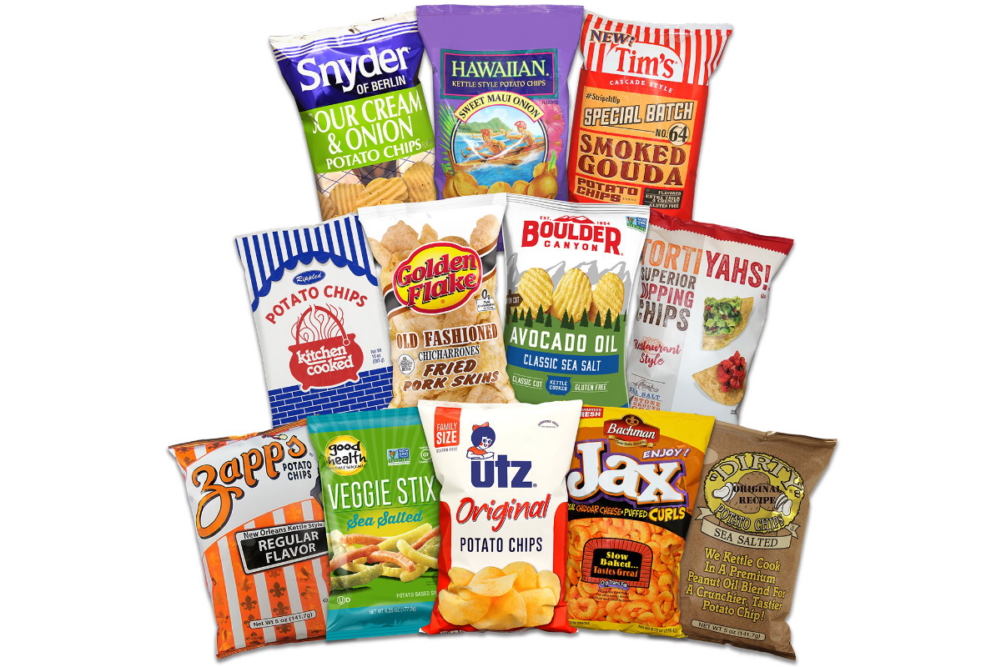NEW YORK — Just after being listed as a publicly traded company, Utz Brands Inc. has scored an outperform rating from Robert Moskow of Credit Suisse. Initiating coverage of Utz, Mr. Moskow identified numerous paths to growth for the Hanover, Pa.-based maker of salty snacks.
With $900 million in sales, Utz is the fourth largest salty snacks company in the United States and has been growing at a compound annual growth rate of 8% for 20 years, Mr. Moskow said.
“Utz is now poised to enter a new chapter of expansion and productivity through recapitalization and reinvestment,” Mr. Moskow said. “We expect the involvement of Collier Creek board members (and ex-Pinnacle Foods executives) will add rigor and process to what was already a well-run, family-controlled operation. These executives can help Utz pick the low-hanging fruit on the cost side, boost efficiency, and reinvest in marketing and channel development. We also see opportunity to add value through M&A, where Utz already has good track record and the industry is ripe for further consolidation.”
On Aug. 28, Utz Quality Foods and Collier Creek Holdings announced the completion of a business combination to form Utz Brands, Inc. and to trade under the ticker symbol UTZ on the New York Stock Exchange.
Utz’s portfolio of brands includes Utz, Zapp’s, Golden Flake, Good Health and Boulder Canyon. For 2020, Mr. Moskow is forecasting Utz EBITDA at $130 million, up 20% from 2019; sales of $931.3 million, up 8%.
The sales growth forecast is fairly modest given that the company’s business grew 11% in the first half of the year. Sales were boosted by the pandemic, and Utz gained market share.
“Utz has expanded the business over the past decade through a series of acquisitions, adding manufacturing capacity, brands, distribution reach, and scale,” he said. “Yet the firm remains under-penetrated in important markets, channels, and sub-categories, with its top four brands present in only 54% of retail stores nationwide. In parts of the US that account for nearly 70% of salty snacks sales, such as Texas, the Midwest, and California, Utz has only 2% share. Similarly, in convenience and mass channels, its LSD% share compares to MSD% in food and club. Finally, its brands are under-represented in the fast-growing tortilla, popcorn, protein, and veggie-based snacks. We estimate these share gain opportunities could represent $500 million to $1 billion in potential retail sales for Utz.”
With annual sales growth of more than 4% over the past 10 years, the salty snacks category is attractive, Mr. Moskow said. The growth rate is more than double the overall packaged foods business.
He described Utz’s brands as “iconic with strong positions.” While the fourth largest company nationally, Utz ranks second in its core Northeast and mid-Atlantic geographies, with a 7% marketing share. The flagship Utz brand accounts for about 60% of total sales.
Management is expected to boost advertising spending to about 3% to 4% of sales, up from 1% in 2019, Mr. Moskow said. Additionally, Utz has targeted cost savings from $50 million of cost of goods productivity from procurement and robotics, optimizing its manufacturing footprint, cutting stock- keeping units and other steps.
“In addition, management expects investments in digital capabilities to lead to improved price-pack architecture, trade spending optimization, and portfolio mix, which can yield 50 to 60 basis points of annual margin gains,” Mr. Moskow said.
Because the company currently was operating at only 69% of manufacturing capacity utilization in 2019, increased sales is another promising way for Utz to lift margins. Over time, Utz is targeting EBITDA margins in the mid-teens, an objective Mr. Moskow believes is achievable and some.
“We think the margin target will prove conservative because it doesn’t appear to take into account the additional 160 basis points of potential upside from price-pack architecture, trade spending optimization, and portfolio mix,” he said. “We are forecasting high-teens percentage EBITDA margin by 2022, similar to what Campbell’s achieved with Snyder’s-Lance, up from mid-teens to high-teens EBITDA margin since the acquisition in 2018.”
Credit Suisse has a 12-month price target for Utz of $19 per share, up from a recent close of $16.34. Offering a handful of risks to Utz’s prospects, Mr. Moskow suggested the company’s success could draw increased attention from industry leader Frito-Lay, Inc. Other potential causes for stumbles include the culture shock from becoming a publicly traded company, failure to generate productivity savings, unsuccessful advertising and difficulty executing acquisitions.
Proceeds from the Collier-Utz transaction were used to reduce Utz debt. The Rice and Lissette family, the founding family and principal owners of Utz, retained more than 90% of their holdings, accounting for a majority of Utz Brands ownership following the transaction.
Dylan Lissette, chief executive officer of Utz since 2013, will continue to head the business together with current management.
“The completion of our business combination with Collier Creek and the initiation of Utz as a public company, marks a significant milestone and will fuel our next century of growth after nearly 100 years as a family-owned business,” Mr. Lissette said. “We have spent the last 10 years building Utz into a national brand and platform through rapid geographic and brand portfolio expansion driven by strategic acquisitions and organic growth. Our partnership with Roger and the Collier Creek team positions us to further accelerate our growth as a public company and achieve our goal of being the fastest-growing, pure-play branded snack company of scale.”





